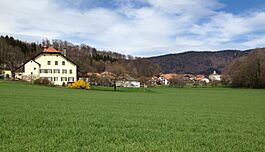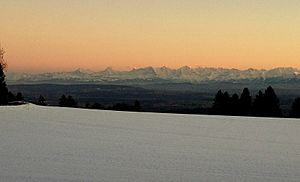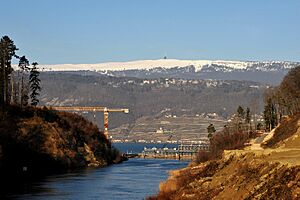Prêles facts for kids
Quick facts for kids
Prêles
|
||
|---|---|---|

Prêles village
|
||
|
||
| Country | Switzerland | |
| Canton | Bern | |
| District | Jura bernois | |
| Area | ||
| • Total | 6.98 km2 (2.69 sq mi) | |
| Elevation | 822 m (2,697 ft) | |
| Population
(Dec 2011)
|
||
| • Total | 908 | |
| • Density | 130.09/km2 (336.9/sq mi) | |
| Postal code |
2515
|
|
| Surrounded by | Nods, Diesse, Lamboing, Twann, Ligerz, La Neuveville, Lignières (NE) | |
Prêles (pronounced prael; its German name is Prägelz) used to be a town in Switzerland. It was located in the French-speaking area called Bernese Jura, within the canton of Bern.
In 2014, Prêles joined with two other towns, Diesse and Lamboing. They all merged to form a new town called Plateau de Diesse.
Contents
A Look at Prêles' Past
Prêles was first mentioned in old records around 1179. Back then, it was called Prales. Later, in 1185, it was known as Preles. People also used to call it by its German name, Prägelz.
A noble family, the de Perls, lived in the area starting in the 1100s. They were around for several centuries. The village was part of a larger territory called Tessenberg. Important landowners included a church in Saint-Imier and a monastery called Erlach Abbey.
Between 1530 and 1554, the village, like the rest of its area, became Protestant. This was part of the Protestant Reformation.
In 1798, France invaded Switzerland. Prêles then became part of a French region called Mont-Terrible. A few years later, in 1800, it moved to another French region, Haut-Rhin. After Napoleon was defeated, Prêles became part of the Canton of Bern in 1815.
In 1912, a cable railway was built. It connected Prêles to Ligerz. This made Prêles a small tourist spot. For many years, farming was the main job in the village. Today, many people who live in Prêles travel to work in bigger cities like Biel or La Neuveville. More houses have been built for these people.
Where Prêles Is Located
Before it merged, Prêles covered an area of about 7 square kilometers (2.7 square miles). A large part of this land, about 62.8%, was used for farming. Forests covered about 27.2% of the area. Buildings and roads took up about 10.5% of the land.
The town of Prêles is located on a high flat area called the Plateau de Diesse. It includes the main village of Prêles and a smaller settlement called Châtillon.
Prêles' Coat of Arms
The coat of arms for Prêles shows a black cauldron on a gold background. A cauldron is a large pot. This symbol represents the old local industry of making pitch, which is a sticky, tar-like substance. This industry has mostly disappeared now.
People Living in Prêles
In 2011, Prêles had a population of 908 people. About 8.8% of the people living there were not Swiss citizens. Over the last ten years, the number of people in Prêles stayed about the same.
Most people in Prêles speak French. About 65.5% of the population spoke French as their first language in 2000. German was the second most common language, spoken by about 30.5% of the people.
In 2008, about 49.6% of the population was male and 50.4% was female. Many people who lived in Prêles in 2000 were born there. Others were born in the same canton or elsewhere in Switzerland. About 11.7% were born outside Switzerland.
In 2011, children and teenagers (up to 19 years old) made up 22.2% of the population. Adults (20 to 64 years old) were 56.8%, and seniors (over 64 years old) were 20.9%.
The number of people living in Prêles has changed over time:

Jobs and Economy
In 2011, the unemployment rate in Prêles was low, at 1.67%. In 2008, 242 people worked in the town.
- About 43 people worked in the primary sector, like farming.
- About 30 people worked in the secondary sector, which includes manufacturing and construction.
- About 169 people worked in the tertiary sector, which includes services like sales, transport, hotels, and healthcare.
Many people who live in Prêles travel to other towns for work. In 2000, 285 workers left Prêles to work elsewhere, while 92 workers came into Prêles for their jobs.
Most people (73.3%) used a private car to get to work. A smaller number (6.3%) used public transportation.
A special funicular (a type of cable railway) called Vinifuni Ligerz–Prêles connects Prêles to the Ligerz railway station.
Religious Beliefs
According to the 2000 census:
- About 57.4% of the people belonged to the Swiss Reformed Church (a Protestant church).
- About 17.9% were Roman Catholic.
- Some people belonged to other Christian churches, or to the Islamic or Hindu faiths.
- About 13.2% of the population did not belong to any church.
Education in Prêles
In Prêles, about 51% of adults have finished high school. About 28.3% have gone on to higher education, like university.
The school system in the Canton of Bern starts with one year of optional Kindergarten. Then, students go to six years of Primary school. After that, there are three years of lower Secondary school. Students are grouped by their abilities. After lower Secondary, students can continue their education or start an apprenticeship.
During the 2011-2012 school year, 30 students attended primary school classes in Prêles. There were no kindergarten classes in the town.
In 2000, 58 students went to school in Prêles. Most of them (41 students) lived and went to school in the town. The other 17 students came from nearby towns. Also, 128 students from Prêles went to schools outside the town.
See also
 In Spanish: Prêles para niños
In Spanish: Prêles para niños






